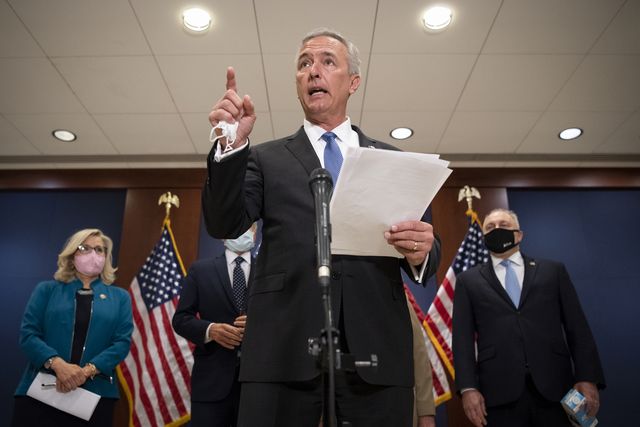Esquire
Republicans Threw Their Own Guy Deep Under the Bus to Avoid a January 6 Commission
Every speaker tried to find a polite way to call John Katko either a rube or a sucker. The end result is that Democrats will need to go on their own.
By Charles P. Pierce May 20, 2021

However, when Mitch McConnell came out on Tuesday as the devious reptile he’s always been, and announced that he was joining House Republican honcho Kevin McCarthy over in Coward’s Corner, the difference was an order of magnitude. These guys were shirking their constitutional obligation and abandoning their moral compasses because a) they lead a party that is very likely complicit in the events, and b) they’re doing so to cover for a crook and a liar who’s in so many crosshairs he looks like Bonnie and Clyde at the end of that movie.
After careful consideration, I’ve made the decision to oppose the House Democrats’ slanted and unbalanced proposal for another commission to study the events of January 6…So, Mr. President, it’s not at all clear what new facts are additional—or additional investigation yet another commission could actually lay on top of existing efforts by law enforcement and Congress. The facts have come out and they’ll continue to come out. What is clear, is that House Democrats have handled this proposal in partisan bad faith going right back to the beginning. From initially offering a laughably partisan starting point to continuing to insist on various other features under the hood that are designed to centralize control over the commission’s process and its conclusions in Democratic hands.
Mitch, my dude, this isn’t a job for grown-ups. And let us all wave farewell to Rep. John Katko, the Republican co-sponsor of the “bipartisan” commission proposal, as he disappears forever under a bus.
Later Wednesday afternoon, debate in the House began on the resolution establishing the commission. The overarching impressions were that, in the debate, the Democrats led with age and the Republicans led with crazy. The first three speakers in defense of the resolution—Nancy Pelosi, Bennie Thompson, and Steny Hoyer—are a combined 235 years old. The Republican side led off with Marjorie Taylor Greene, Louis Gohmert, and some guy from North Carolina named Sam Bishop, who wanted to make sure everybody knew that what happened on January 6.
Let me say this, if it was an insurrection, it was the worst example of an insurrection in the history of mankind. It was a riot. It was a mob. And it was significant. And it was troublesome. But this is not bipartisanship. And I fear that the gentleman from New York may find that he has been played.
Personally, I think the passel of elderly Communist inebriates who tried to overthrow future Pizza Hut spokesman Mikhail Gorbachev back in August of 1991 are still the gold standard for insurrectionist clownery. (They got faced down by Boris Yeltsin, reportedly because, against all possible odds, some of them were drunker than Yeltsin was.) That, however, is beside the point. I would draw your attention to that last sentence in which John Katko returns to his place under the wheels.
Watching Katko straddle the crazy to get the resolution he co-sponsored passed made you fear for every hamstring the man owns. Speaker after speaker tried to find polite ways to call Katko either a rube or a sucker. Meanwhile, the Democrats, in the person of co-sponsor Thompson, seem convinced that the fact that the resolution is “bipartisan” has some ultimate legislative salience in the Congress, and some ultimate political salience in the country, which is something I doubt profoundly. People don’t give a fck about bipartisanship. It’s neither a dealmaker nor a dealbreaker. It’s a green-room amenity, like sodas and a crudité plate. Thankfully, Rep. Tim Ryan showed up to inveigh against the futility of it all.
To the other 90% of our friends on the other side of the aisle, holy cow. Incoherence. No idea what you’re talking about. Benghazi, you guys chased the former Secretary of State all over the country, spent millions of dollars. We have people scaling the Capitol, hitting the Capitol police with lead pipes across the head and we can’t get bipartisanship. What else has to happen in this country? Cops, this is a slap in the face to cops across America. If we’re going to take on China, reverse climate change, we need two political parties in this country that are both living in reality and you ain’t one of them.
To which Katko responded in his best hall-monitor voice that things were getting impermissibly partisan and emotional. Because, when you come right down to it, John Katko is a Republican, too. At loose moments, he let that slip through. For example, the regular GOP stance on the commission is that it ought to investigate the disturbances last summer following the murder of George Floyd. (Rep. Marjorie Taylor Greene ranted about them in her one minute of debate time.) But Katko tried another tack.
And of course we can’t forget the 2017 terrorist attack against Republican members of Congress during practice for the congressional baseball game. Were it not for the officers involved, there would be scores of dead congressmen. That’s the plain truth.
This is a matter of comparing apples and salamanders. The 2017 episode was the work of one man, James Hodgkinson, and he was killed by the officers at the scene. There was a Secret Service investigation almost immediately after the shooting. As far as I know, there haven’t even been rumors of other people involved in the shooting. Hodgkinson was vocal in his dislike of Republicans and clearly came to the ballfield to attack them that morning, but he did it all on his own. An awful event, certainly, but if Katko thinks a 1/6 commission should examine it, then he’s as invested in delay and deflection as Greene is.
And, unless Mitch McConnell is taken off to glory and replaced by Zombie Paul Douglas, this thing is as dead as Kelsey’s nuts in the Senate anyway. Ten Republicans would have to vote for it and, well, no. It’s time for Democrats simply to put together a select committee of their own, issue subpoenas, and let the chips fall.
















